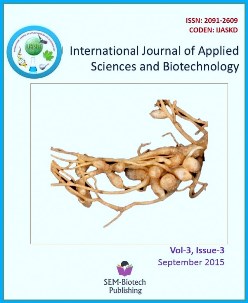Biodegradation of Synthetic Dye by Endophytic Fungal Isolate in Calotropis procera Root
DOI:
https://doi.org/10.3126/ijasbt.v3i3.13136Keywords:
Synthetic dye, endophytic fungus, decolourization, Minimal mediumAbstract
In this study, based on colony morphology characteristics, a total of 19 fungal endophytes were isolated from root of Calotropis Procera a traditional Indian medicinal plant. All fungal isolates were screened for their dye degradation ability. The dyes used as test dyes were Rose Bengal (RB), azo dye Methyl Red (MR), Coomassie Brilliant Blue (CBB) and Methylene Blue (MB) and the concentration of each dye in the experiment was kept 100mg/L. Among the 19 fungal endophytic isolates (CPR1-CPR19), only one isolate CPR4 showed strong dye decolourization capability against all the four test dye. Dye decolourization ability by the isolate CPR4 was determined to be 97.4%, 87%, 65% and 45% for Rose Bengal (RB), Methyl Red (MR), Coomassie Brilliant Blue (CBB) and Methylene Blue (MB) respectively. Complete colour decolourization was observed with rose Bengal followed by Methyl Red. Glucose minimal medium was used for liquid and solid culture of fungal isolates. Fungal biomass production in the presence of four test dye was studied and compare with control culture of fungal endophytes. Effect of temperature, pH, stationary and agitation conditions on dye degradation was also studied.
Int J Appl Sci Biotechnol, Vol 3(3): 373-380




